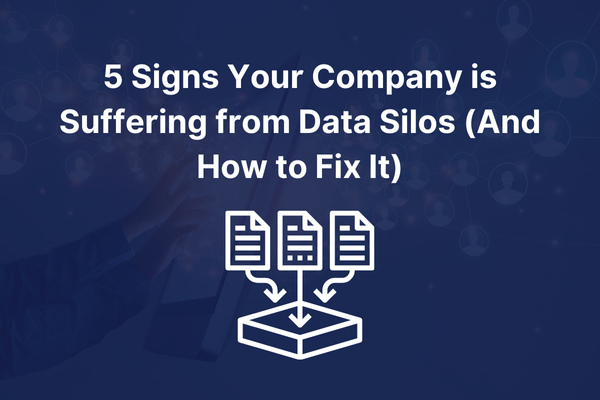Business

5 Signs Your Company is Suffering from Data Silos (And How to Fix It)
Introduction
Data silos form when companies store their data in isolated repositories that are difficult for other departments or systems to access or share. Silos often emerge over time and tend to reflect the organization’s structure and departmental divisions. These pockets of data are typically disconnected from other data sources, with limited access to information, and stored in formats that are incompatible with other systems. Breaking down data silos can have great value across your company, from improved decision-making, greater efficiency across departments, and opportunities for innovation.
How do you know if data silos are holding your company back and it’s time to integrate your data? Here are five signs that signal the need for change.
Sign 1: Your Departments Are Using Different Software Systems
Do your teams use different tools for similar tasks? For example, a mid-sized manufacturing company has separate tools for customer management. The Sales team uses one CRM to track leads and interactions, while the Marketing team uses a different CRM to manage campaigns and customer engagement. Meanwhile, the Operations team relies on a standalone ERP system to track orders and inventory. These systems don’t communicate with each other, leading to redundant data entry and inconsistencies in customer information across departments.
Challenges:
Your sales and marketing teams might have conflicting records of customer interactions, causing confusion during any lead follow-up from either team. Operations have limited visibility into potential/upcoming sales from the Sales CRM, making it harder for them to prepare for future inventory needs. The manual data transfer between systems wastes time and invites errors, slowing down workflows across departments. Decision-makers also cannot see a unified view of customer data, leading to inefficient resource allocation and poor strategic planning.
Sign 2: Poor Data Quality Across the Organization
Does each department have its own methods of inputting, formatting, and storing data? For example, a retail company tracks customer orders through different departments, Sales, Inventory, and Customer Support, to name a few. Each department manages its own data, but inconsistencies are starting to emerge. The Sales department records a customer order as “completed,” but inventory marks it as “pending due to stock shortage,” and Customer Support logs the same order as “shipped.” Moreover, customer profiles have duplicates, with different spellings or addresses across departments.
Challenges:
Sales reports show inflated numbers due to duplicate records, while inventory managers struggle to reorder stock because of outdated information. Customer Support is experiencing delays in responding to complaints, leading to customer dissatisfaction. Additionally, decision-makers are receiving conflicting reports on sales performance and stock levels, resulting in confusion and poor resource allocation.

Sign 3: Slow Decision-Making Processes
Do you find that decision-making takes longer because managers must manually gather data from various departments? For example, a healthcare organization experiences delays in decision-making do to manual data gathering. The Finance department must collect reports from Human Resources, Patient Care, and Procurement to prepare quarterly forecasts. Each department stores its data in different systems, and the data often requires manual aggregation, resulting in weeks of delay. By the time executives receive the reports, the data needs to be updated, affecting their ability to promptly respond to budget changes, patient needs, or procurement issues.
Challenges:
Management faces challenges in making timely decisions due to the slow collection of data, which causes the organization to lose competitiveness as it struggles to respond quickly to market changes and internal inefficiencies. Decision-makers lack a clear, real-time view of operational performance, leading to suboptimal strategic planning. Meanwhile, teams spend excessive time manually compiling reports, diverting their focus from more valuable tasks.
Sign 4: Lack of Transparency and Collaboration Between Teams
Is there a lack of transparency between teams within your company – leading to a lack of communication, knowledge sharing and collaboration? For example, in a large financial services company, different departments (e.g., Risk Management, Compliance, and Customer Service) operate independently, rarely sharing information with one another. Risk Management collects essential data on market trends and customer behaviors that would benefit Compliance in regulatory audits, but there’s no established process for sharing this information. Customer Service often deals with issues that could be flagged earlier by Risk Management, but they have no access to that team’s insights. As a result, strategic projects that require input from multiple teams get delayed or face significant gaps due to the lack of collaboration and shared data.
Challenges:
Strategic initiatives, such as new service launches, are stalled because teams lack access to relevant data from other departments, leaving employees feeling disconnected and operating in silos, unaware of how their work impacts other teams or overall company goals – poor knowledge sharing results in missed opportunities to optimize services or meet regulatory requirements efficiently. Additionally, efforts to innovate or respond to customer needs suffer as employees need help collaborating across departments.
Sign 5: Customer Experience Suffers
Do your customers get frustrated with delays from your company due to isolated data? For example, a property management company receives a complaint from a tenant about illegal fly-tipping on a piece of land adjacent to their building. However, the customer service team is unsure whether the company owns the land and has to reach out to the legal department for clarification. The process of identifying who is responsible for that piece of land takes time, and further delays arise when trying to coordinate with contractors to remove the waste. The tenant grows frustrated by the slow response, as multiple teams are involved, each working in separate systems with no unified access to property ownership records or contractor schedules.
Challenges:
The customer service team faces delays in resolving tenant complaints due to a lack of access to real-time property ownership data. Meanwhile, multiple departments, including legal and operations, operate in silos, resulting in inefficient communication and slow coordination with contractors. The absence of a centralized platform leads to disjointed service, frustrating tenants and ultimately damaging customer satisfaction.

How to fix it:
To address common issues like fragmented data, inconsistent software usage, slow decision-making, and poor customer experiences, implementing a comprehensive solution like the Cyferd platform can provide the key to transformation.
Implement a Unified Platform for Seamless Collaboration
Cyferd’s platform helps businesses eliminate silos by unifying data across all departments. Fostering seamless collaboration and ensuring all teams work from the same real-time data. By centralizing your systems, you can remove the friction caused by inconsistent software across departments and enable cross-functional teams to work more efficiently together.
Centralize and Automate Data Management
With Cyferd, organizations can centralize all their data in one unified data layer, enhancing accessibility and accuracy, thus preventing issues like poor data quality and discrepancies and allowing real-time updates and consistent data for faster decision-making. Cyferd also uses AI-driven data automation to cleanse and standardize information, reducing the need for manual intervention.
Integrating and Augmenting Existing System Using Cyferd
Integrate and enhance your existing systems with Cyferd by centralizing all operations and building workflows and integrations that connect seamlessly with your current tools. This approach enables you to maintain connectivity without the need to replace your existing systems and workflows. By establishing these connections, you can eliminate the reliance on Excel workarounds and prevent data from leaving the system.
Leverage AI for Continuous Optimization
Cyferd’s Neural Genesis AI Engine transcends basic automation by being explicitly trained on your organization’s data, creating a unified AI that operates seamlessly across all workflows and applications. Eliminating the need to manage multiple AI systems, reducing complexity, and preventing “AI creep.” With advanced analytics and machine learning, it predicts trends and optimizes processes in real-time, ensuring your organization remains agile, efficient, and innovative. By centralizing AI functions, Neural Genesis drives cohesive, data-driven outcomes, enhancing your business’s ability to compete and grow sustainably.
Find out more About Cyferd
New York
Americas Tower
1177 6th Avenue
5th Floor
New York
NY 10036
London
2nd Floor,
Berkeley Square House,
Berkeley Square,
London W1J 6BD
